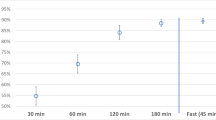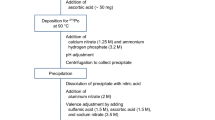Abstract
The ever-increasing sensitivity of ICPMS continues to expand the technique’s application in the field of health physics. Enhancements in sample introduction and instrument design over the last few years have resulted in improving the ICPMS detection limit from ∼10 ng/l to≤0.1 ng/l. This additional sensitivity provides greater flexibility in the analysis of long-lived radionuclides in biological fluids, and requires only minimal sample preparation of urine for uranium analysis; the described 3-minute abbreviated matrix separation provides detection limits that are comparable to or better than alpha counting. For urine samples tested having concentrations that exceed the accepted administrative limit for total uranium (0.2 μg/day), isotopic analysis by ICPMS (e.g., determining the presence of236U, or measuring appropriate uranium isotope ratios) provides a reliable indication of occupational exposure. Our laboratory also utilizes ICPMS in a study examining uranium dissolution rate classification of dust collected at the perimeter of a nuclear facility. Specific details regarding these and other health physics applications are featured, including our group’s participation in assisting the DOE with the evaluation of ICPMS as a cost-effective alternative to fission-track analysis for the routine determination of239Pu in urine.
Similar content being viewed by others
References
M. R. Smith, E. J. Wyse, D. W. Koppenaal, J. Radioanal. Nucl. Chem., 160 (1992) 341.
B. G. Ting, D. C. Paschal, K. L. Caldwell, J. Anal. Atomic Spectrom, 11 (1996) 339.
R. R. Ross, J. R. Noyce, M. M. Lardy, Radioact. Radiochem., 4 (1993) 25.
A. P. M. Heres, M. C. Noe, Nucl. Techn., 115 (1996) 146.
T. U. Probst, Fresenius J. Anal. Chem., 354 (1996) 782.
J. I. G. Alonso, D. Thoby-Schultzendorff, B. Giovanonne, L. Koch. J. Anal. Atomic Spectrom, 8 (1993) 673.
P. Twiss, R. J. Watling, D. Delev, Atomic Spectrosc. Jan/Feb (1994) 36.
Y. Igarashi, K. K. Chang, Y. Takaku, K. Shiraishi, Y. Masayoshi, N. Ikeda. Anal. Sci., 6 (1990) 157.
D. Guenther, H. P. Longerich, S. E. Jackson, Can. J. Appl. Spectrosc., 40(4) (1995) 111.
X. Chen, R. S. Houk, J. Anal. Atomic Spectrom., 10 (1995) 837.
D. R. Kalkwarf, NUREG/CR-0530, 1979.
D. R. Kalkwarf, NUREG/CR-1428, 1979.
D. R. Kalkwarf, NUREG/CR-1316, 1980.
ICRP Task Group, Health Phys., 12 (1966) 173.
E. J. Wyse, D. R. Fisher, Radiation Prot. Dosim., 55 (1994) 199.
E. J. Wyse, D. R. Fisher, Department of Energy Publication CONF-9304128, 1993, E-15.
Author information
Authors and Affiliations
Rights and permissions
About this article
Cite this article
Wyse, E.J., MacLellan, J.A., Lindenmeier, C.W. et al. Actinide bioassays by ICPMS. J Radioanal Nucl Chem 234, 165–170 (1998). https://doi.org/10.1007/BF02389766
Received:
Issue Date:
DOI: https://doi.org/10.1007/BF02389766




